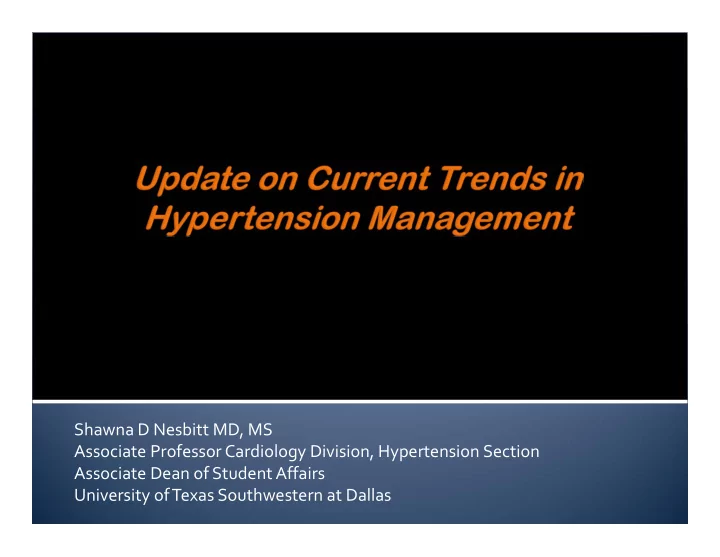

Shawna D Nesbitt MD, MS Associate Professor Cardiology Division, Hypertension Section Associate Dean of Student Affairs University of Texas Southwestern at Dallas
Speakers Bureau: Lundbeck, Amgen Consultant: Lundbeck, Amgen Major Stock shareholder: None Other support, Tangible or intangible: None
Present the current epidemiology of hypertension Review the core elements of hypertension diagnosis and classification which are essential to all of the guidelines. The SPRINT Trial Results and implications for treatment goals
Nearly One in Three US adults has Hypertension: Prevalence of 33.5% Awareness 100 US Population With Hypertension (%) Treatment Control (treated)* Control (treated hypertensive diabetics) † 80 Control (all with hypertension)* 60 40 50% 20 0 1999-2000 2001-2002 2003-2004 2007-2008 (n=1530) (n=1500) (n=1614) *Blood pressure (BP) <140/90 mm Hg in non ‐ diabetic patients or BP <130/80 in diabetic patients. † BP <130/80 mm Hg. Ong KL et al. Hypertension . 2007;49:69 ‐ 75. Egan BM JAMA 2010;303:2043 AHA Statistics 2011 Circ 2011;123:e18
Roger V Circulation 2011;123:e18
JNC 7 Definitions Blood Pressure (mm Hg) Category Systolic Diastolic <120 and <80 Normal 120-139 or 80-89 Prehypertension 140-159 or 90-99 Stage 1 hypertension ≥ 160 or ≥ 100 Stage 2 hypertension Chobanian AV, et al. Hypertension 2003;42:1206 ‐ 52
How did they get there?
From: 2014 Evidence-Based Guideline for the Management of High Blood Pressure in Adults: Report From the Panel Members Appointed to the Eighth Joint National Committee (JNC 8) JAMA. 2013;():. doi:10.1001/jama.2013.284427 2014 Hypertension Guideline Management Algorithm. SBP indicates systolic blood pressure; DBP, diastolic blood pressure; ACEI, angiotensin-converting enzyme; ARB, angiotensin receptor blocker; and CCB, calcium channel blocker. a ACEIs and ARBs should not be used in combination. b If blood pressure fails to be maintained at goal, reenter the algorithm where appropriate based on the current individual therapeutic plan.
Aged over 55 years or black person of African or Caribbean Aged under family origin of any 55 years age C 2 A Step 1 Key A: ACEI or low-cost ARB 1 A + C 2 Step 2 C: CCB D: Thiazide-like diuretic A + C + D Step 3 Resistant hypertension Step 4 A + C + D + consider further diuretic 3, 4 or alpha- or beta-blocker 5 Consider seeking expert advice NICE Guidelines 2012
Risk Category Recom m endation Goal BP Prim ary Prevention Lifestyle Modification* BP ≥ 135/85 mmHg without <135/85 mmHg (up to 3 months without target-organ damage,† preclinical CVD,‡ or CVD § drugs) + Drug Therapy Secondary Prevention/ Target-Organ Dam age BP ≥ 130/80 mmHg with Lifestyle Modification <130/80 mmHg target-organ damage,† preclinical CVD,‡ and/or the + Drug Therapy presence of CVD § *Up to 3 months of comprehensive lifestyle modification without drugs if BP <145/90 mmHg without target ‐ organ damage or other risk ‐ enhancing comorbidities. †Target ‐ organ damage is defined as albumin:creatinine ratio >200 mg/g, estimated glomerular filtration rate (eGFR) <60 mL/min/1.73 m 2 , or electro ‐ or echocardiographic evidence of left ventricular hypertrophy (LVH). ‡Indicators of preclinical CVD: metabolic syndrome, Framingham risk score >20%, prediabetes (impaired fasting glucose [100 ‐ 125 mg/dL] and/or impaired glucose tolerance [2 ‐ hr postload glucose of 140 ‐ 199 mg/dL]), diabetes mellitus. §CVD includes heart failure (systolic or diastolic), CHD/post ‐ myocardial infarction, peripheral arterial disease, stroke, transient ischemic attack, and/or abdominal aortic aneurysm. Hypertension 2010;56:780
SPRINT TRIAL: Systolic Blood Pressure Intervention Trial A Randomized Trial of Intensive versus Standard Blood-Pressure Control N Engl J Med 373(22):2103-2116 November 26, 2015
The SPRINT Research Group. N Engl J Med 2015;373:2103-2116
SPRINT TRIAL: Systolic Blood Pressure Trend The SPRINT Research Group. N Engl J Med 2015;373:2103-2116
SPRINT Trial: Primary Outcome and Death from Any Cause. The SPRINT Research Group. N Engl J Med 2015;373:2103-2116
SPRINT Study Primary Outcome According to Subgroups The SPRINT Research Group. N Engl J Med 2015;373:2103-2116
SPRINT Trial: Baseline Characteristics of the Study Participants. The SPRINT Research Group. N Engl J Med 2015;373:2103-2116
SPRINT TRIAL: Primary and Secondary Outcomes and Renal Outcomes. The SPRINT Research Group. N Engl J Med 2015;373:2103-2116
SPRINT TRIAL: Primary and Secondary Outcomes and Renal Outcomes. The SPRINT Research Group. N Engl J Med 2015;373:2103-2116
SPRINT Trial: Serious Adverse Events, Conditions of Interest, and Monitored Clinical Events. The SPRINT Research Group. N Engl J Med 2015;373:2103-2116
SPRINT TRIAL CONCLUSION
Outcomes Data from SPRINT and the ACCORD Trial and Combined Data from Both Trials.
43
44
Population ‐ Based Strategy SBP Distributions SBP<135 SBP<140 After Before Intervention Intervention Reduction in BP Reduction in % Reduction in Mortality SBP mmHg Stroke CHD Total 2 –6 –4 –3 3 –8 –5 –4 5 –14 –9 –7
AHA/ACC Hypertension Algorithm. Go A et al Hypertension 2014;63:878 ‐ 885
Previous Guidelines recommend treatment goal of <140/90140/90 for most of the population. Recent trials such as ACCORD and SPRINT suggest different goals for specific populations ACCORD: Diabetics <140/90 SPRINT: Non ‐ diabetics <120/80 SPRINT: There are differences in outcomes by CKD and age. This may affect new recommendations All of the guidelines have removed beta blockers from the first line of therapy. ( ACE/ARB, CCB, Diuretics are first line treatment options) EXPECT NEW GUIDELINES FROM AHA/ACC/ASH in 2016 ‐ 2017
Recommend
More recommend